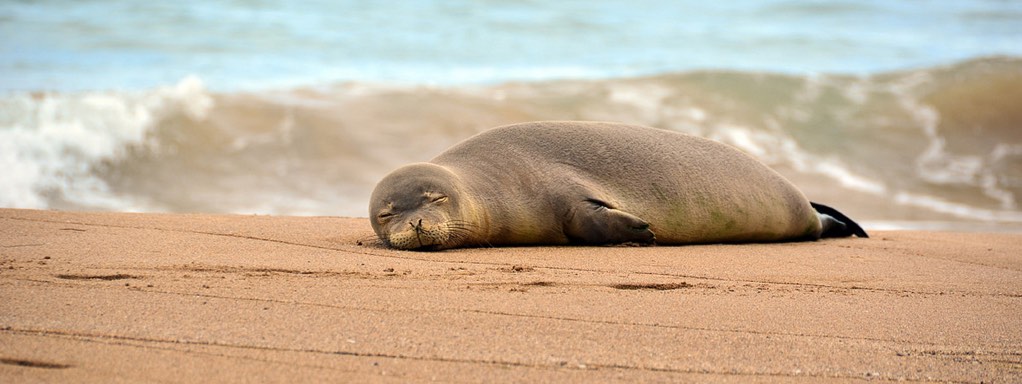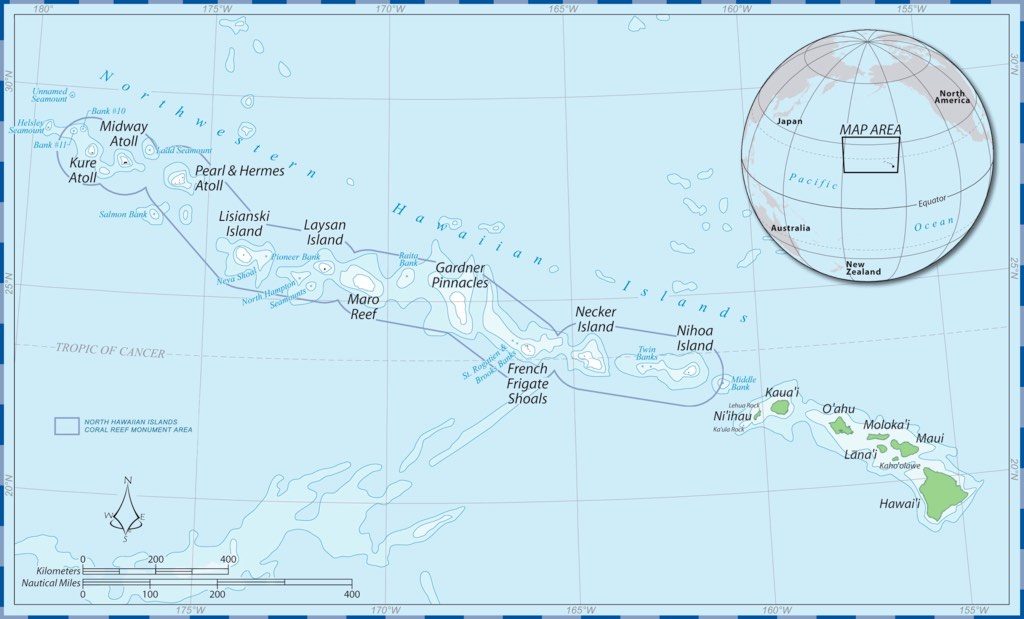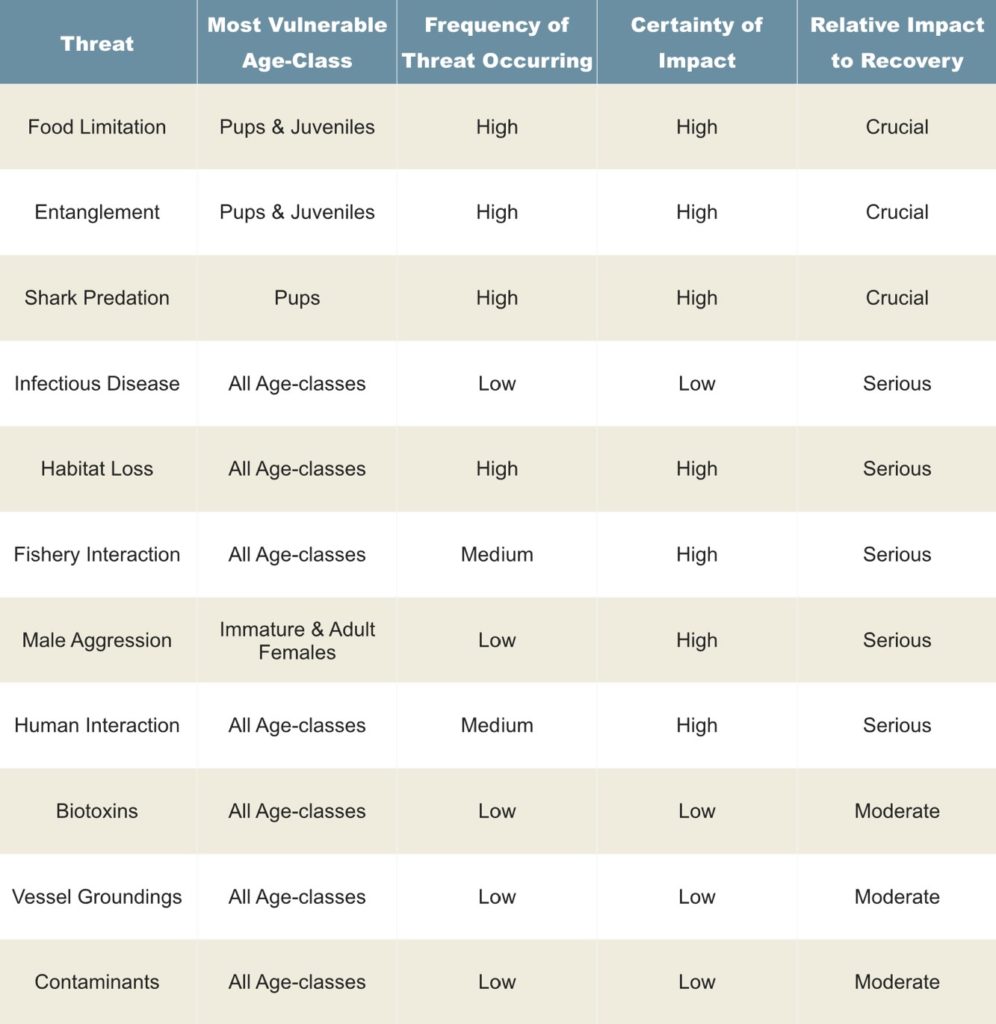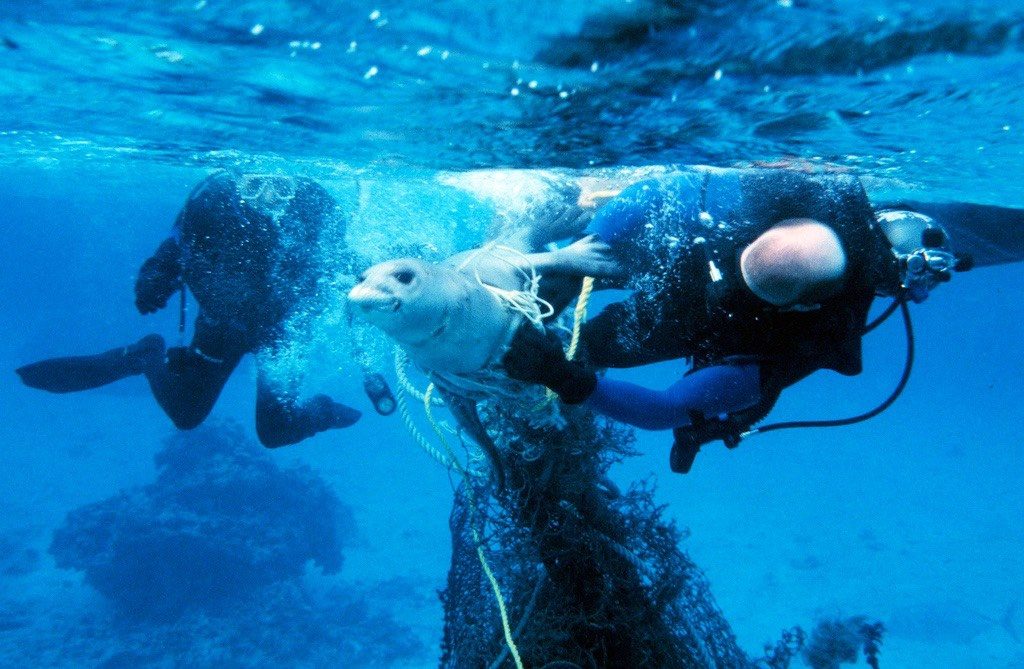Population Ecology
5.2 Saving Juvenile Hawaiian Monk Seals- Status and Challenges
Rika L. Bailey
The Hawaiian Monk Seal is an ancient seal species indigenous to the Hawaiian Islands. Human interference, coupled with difficult pup rearing, is causing their population to decrease by 4% annually. Human attempts to revitalize the Hawaiian Monk Seal population could determine if the species will survive.

Photograph by Geordie Mott, 2010. CC BY-ND 2.0.
The Hawaiian Monk Seal (Monachus schauinslandi) is considered an ancient seal species, and it is indigenous to the Northwestern Hawaiian Islands (Figure 1). Often referred to as a “living fossil”, they are one of only two monk seal species remaining, and their population continues to dwindle at a rate of near 4% annually.1 Their population is estimated to be 1000-1500 in number, with the largest percentage living in the French Frigate Shoals, the largest atoll of the Northwestern Hawaiian Islands (Figure 2). Much like the buffalo population of North America, the Hawaiian Monk Seal was hunted to near extinction by expeditions during the mid-1800s.1

Courtesy of the U.S. National Oceanic and Atmospheric Administration, 2006. Public Domain.
Burgeoning threats to the Hawaiian Monk Seal population include increasing amounts of marine debris in their habitat, aggressive mating practices, lack of genetic diversity due to low population size, increased presence of disease, environmental contaminants, human interference (including bycatch practices), foraging issues, and general human encroachment onto their habitat.1 Perhaps the greatest threat to the Hawaiian Monk Seal population is the inability of juvenile seals to survive (Figure 3). Only one in five pups born will live to reproductive age.1,2 Juvenile foraging practices and the role that monk seal mothers play in fostering these practices, yields insight into the development of seal pups and their high mortality rate.
Though the population is decreasing at a dramatic rate, concentrated attempts to salvage and facilitate the growth of young Hawaiian Monk Seals may determine the survival of the species.

The top three threats to the Hawaiian Monk Seal (Food Limitation, Entanglement, and Shark Predation) most seriously affect seal pups and juveniles. Addressing the low survival rate of young Hawaiian Monk Seals is crucial to the recovery of the species.
Table modified from the National Marine Fisheries Service, 2007.
Female Hawaiian Monk Seals do not breed as consistently as other seal species, although this does not cause much disparity in the amount of pups being born.2 Rather, the female’s inability to identify her own pup alongside the pup of another female causes many juveniles to become orphaned. However, the rate of fostering within this species is so high that orphaned juveniles tend to find another female to take care of them.2 This occurs because either a female has lost her own pup, or is willing to take up the orphaned pup in addition to her own. Oftentimes, the density of the breeding population is low and females will have aggressive encounters in which they end up switching offspring.3 Fostering practices have little impact on the weight of the seal pup, which is often the largest determining factor into whether the seal pup will survive its first year.4 The mother will only lactate for the seal pup for slightly over a month and during this time she is not eating. After this lactation period, the seal pup will have to fend for itself. It is during this weaning period that a seal pup must learn to forage for benthic organisms, the primary prey of Hawaiian Seal Monks. Seal pups tend to stay closer to shore where they are protected from predators, but where prey is harder to catch. Limited availability of prey and their smaller size makes pups more susceptible to starvation, predation, and increased risk of developing diseases.4 Juvenile pups are also harassed by aggressive male seals. Other than elevated testosterone levels, the reason for this behavior is relatively unknown.5
Female Hawaiian Sea Monks are often the victims of mobbing, in which more than one male seal tries to mate with a single female at once. Mobbing often results in injury and may kill the female.2 Despite the mobbing behavior, females are often injured during mating due to the method in which the male mounts the female. Male monk seals hold onto the female’s back with their teeth, which can lead to gashes and subsequent infection.2
Human interference has greatly influenced Hawaiian Monk Seal populations. Hawaiian Monk Seals primarily live in the protected Marine National Monument (Figure 2), but prior to its establishment in 21st century, the Northwestern Hawaiian Islands were home to various United States Coast Guard and Navy activities and bases.6 Hawaiian Monk Seals were no longer able to ‘haul out’ onto optimal shore areas (shallow and protected by reefs) to undergo parturition because of human interference. The seals were forced to go to less productive areas that were more exposed to predators including sharks, or deeper areas where pups faced the possibilities of drowning.2 Once a noticeable decline in the population of Hawaiian Monk Seals was discovered, human activity on or near the military bases became more regulated, and the population recovered. Hawaiian Monk Seals have also been affected by the amount of human debris washing onto the shores of the Northwestern Hawaiian Islands, which includes fishery nets that can entangle seals and cause drowning (Figure 4). Efforts to minimize beach debris have not significantly reduced the waste.6

Photograph by Ray Boland, 2010. CC BY 2.0.
Human efforts at rehabilitating the Hawaiian Monk Seal population have had limited success, because protected marine areas are not enough to sustain the population. Programs have been established to foster healthy female pups until they are of reproductive age and then return them to their original nesting site to ensure the best chance of survival and reproduction. However, it is difficult to determine whether the rehabilitated females are producing surviving offspring because of the high rate of displacement among pups.7 Although the overall population of the Hawaiian Monk Seal continues to decline, monk seals populations on the Main Hawaiian Islands (versus the Northwestern Hawaiian Islands) are growing. Also, these main island populations have more reproductive females that are necessary for the survival of the species.5
With the advent of new technology, monitoring Hawaiian Monk Seal behavior (particularly pup behavior) is becoming easier and more efficient. Video-monitoring devices such as the CritterCam are providing new possibilities for observation that were previously unavailable.8 Observation technology may provide critical insight on Hawaiian Monk Seal behavior, foraging practices, environment, and social interactions.8 More research is needed on the low survival rates of juvenile Hawaiian Monk Seals to determine the best methods to support species growth and reverse the population decline.
References
- Seal Conservation Society. (2011 August). Hawaiian Monk Seal. Retrieved from http://www.pinnipeds.org/seal-information/species-information-pages/the-phocid-seals/hawaiian-monk-seal
- Johanos, T.C. et al. (1994). Annual Reproductive Cycle of the Female Hawaiian Monk Seal (Monachus Schauinslandi). Marine Mammal Science, 10:13-30.
- Boness, D.J. (1990). Fostering Behavior In Hawaiian Monk Seals: is there a Reproductive Cost?. Behavioral Ecology and Sociobiology, 27:113-122.
- Craig, M.P. & Ragen, T.J. (1999). Body size, survival, and decline of juvenile Hawaiian Monk Seals, Monachus schauinslandi. Marine Mammal Science, 15:786-809.
- National Oceanic and Atmospheric Administration. (2013 February 17), Hawaiian Monk Seal (Monachus Schauinslandi). Retrieved from http://www.nmfs.noaa.gov/pr/species/mammals/pinnipeds/hawaiianmonkseal.htm
- Gerrodette, T. & Gilmartin, W.G. (1990). Demographic Consequences of Changed Pupping and Hauling Sites of the Hawaiian Monk Seal. Conservation Biology, 4:423-430.
- Gilmartin, W.G., et al. (2011). Rehabilitation and Relocation of Young Hawaiian Monk Seals (Monachus Schauinslandi). Aquatic Mammals, 37:332-341.
- Marshall, G.J. (1998). CRITTERCAM: An animal borne imaging and data logging system. Marine Technology Society Journal, 32:11-17.
- Mott, Geordie. (2010). [Photograph of a Hawai’ian Monk Seal sleeping on a beach]. Retrieved from FlickrCommons. CC BY-ND 2.0.
- National Oceanic and Atmospheric Administration. (2006). [Map of The Papahānaumokuākea Marine National Monument in Hawai’i]. Retrieved from Wikimedia Commons. Public Domain.
- National Marine Fisheries Service. (2007). Hawaiian Monk Seal (Monachus schauinslandi) 5-Year Review: Summary and Evaluation. Retrieved from http://www.fisheries.noaa.gov/pr/pdfs/species/hawaiianmonkseal_5year.pdf
- Boland, Ray. (2010). [Photograph of two divers freeing a Hawaiian Monk Seal from a commercial fishing net]. Retrieved from FlickrCommons. © U.S. National Oceanic and Atmospheric Administration. CC BY 2.0.
